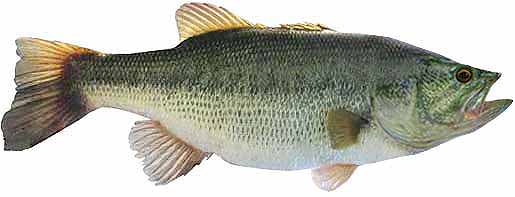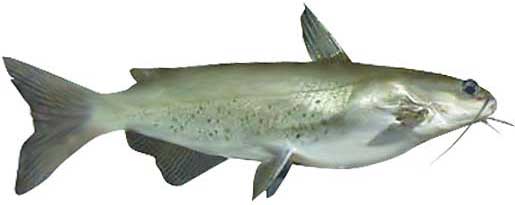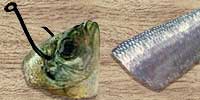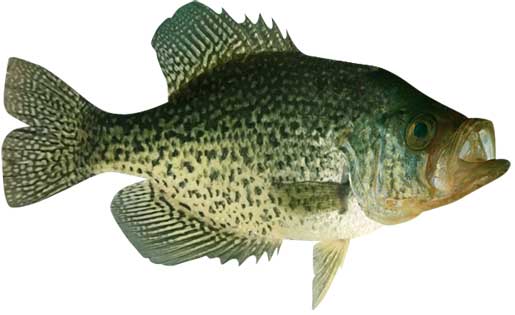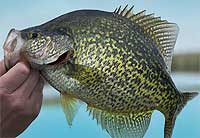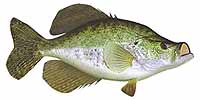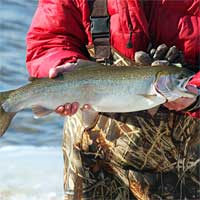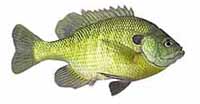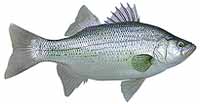Fishing Report For Buckhorn Lake, NC
AKA: Buckhorn Reservoir
By Rick Seaman
Last updated on .
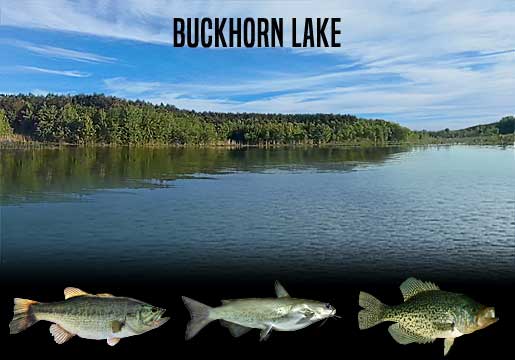
Fishing Reports
Popular Fish Species Buckhorn Lake, NC
Largemouth Bass
Current Report: Poor To Good
FALL. Now that Fall has arrived, bass here have moved shallow, following schools of baitfish into coves and shallow bays around 4 to 12 feet of water. This is a decent bass fishery, but not top tier. Bass tend to follow the baitfish here, so using electronics to locate schools can be a big help. Currently topwater, jerkbaits, crankbaits, and slow-rolled spinnerbaits are catching most of the bass. Later in Fall, as deeper water cools, bait and bass move out to ledges, channel edges, points and humps where flutter spoons, jigs and drop shots are often good choices in 8 to 15 feet of water.
WINTER. Winter will isolate largemouth around slightly deeper structure, flats, points and creek channels. They can be found from 15 to 20 feet deep. Here they hold, feeding less frequently, awaiting warmer water to return in Spring. Slow presentations are key to getting bites.
SPRING. Once water temperatures rise into the low 60's, largemouth will move from deep wintering holes, to shallower water nearby spawning areas. Vibrating jigs, jerkbaits and spinnerbaits typically get bites just away from the shoreline. At this time they are feeding aggressively in about 5 to 15 feet of water, preparing for the spawn. Once water warms into the mid to high 60's, they will move into 2 to 5 feet of water, and create nests, then lay their eggs. Immediately afterwards, females move to deeper water and males remain to guard the eggs, and then the fry. After a couple weeks, the males also move to slightly deeper water. Deep-diving crankbaits, vibrating jigs, plastic worms and swimbaits are catching bass during this period.
SUMMER. Water temperatures will warm considerably in Summer. Bass will feed shallow, early and late in the day, where they will be caught in 5 to 15 feet of water. Topwater, square-bill crankbaits and spinnerbaits. Wacky-rigged stick worms always catch finicky bass when the bite is slow. Largemouth bass here feed on gizzard shad, threadfin shad, small sunfish and crawfish. During the hotter parts of the day, they are being caught on points, channel edges, and ledges 15 to 20 feet deep. Once they move deep during summer and winter, light line, small baits and slow presentations can trigger strikes. Local anglers report that drop shot rigs catch a lot of bass here.
Channel Catfish
Current Report: Good To Very Good
FALL. Fall is one of the better times of year for catching channel catfish. Channel cats are one of the easiest species to catch here at Buckhorn Lake. Fishing from the Mill Branch area to the Buckhorn Lake Dam, and the deeper sections of the Little Creek Arm, have produced pretty consistent action of late. Early in Fall they cruise the shallows, in search of food. Later, in the season they migrate away from the shallows and current, to moderately deep flats and channel edges on the main body of the lake. They can typically be found from 5 to 15 feet deep. Fishing for channel catfish is often productive around any kind of structure. Road beds, creek channels and rocky points are all good places to begin. Drift fishing or slow-trolling baits along mid-depth structure is popular and generally productive. Use a slip sinker or Carolina rig setup. Use cut bait, nightcrawlers, shrimp or prepared baits. They remain in these areas and feed aggressively in preparation for Winter.
WINTER. In Winter, the channel cats gather in deep holes and go virtually dormant, especially if water cools into the 40's. They hole up in pockets, deeper channels, ledges, and the basin areas from 10 to the deepest regions of the lake and await warmer water. Slow presentations, especially cut bait, can still entice strikes. Often mid day through the afternoon anglers are catching them a bit shallower on the same structure.
SPRING. In Spring, when water temperatures rise into the high 40's, channel catfish start their migration into coves and up river. Look for them in 4 to 12 feet of water. They hold here, and feed aggressively, around relatively shallow cover until water warms into the mid 70's, at which time they begin the spawn process. Anglers are using slip sinkers, 3-way rigs, or Carolina rigs to get, and keep, the bait close to the bottom. Focus on shallow flats in late evening. There are good numbers of 2 to 2 1/2 pound channel catfish being caught.
SUMMER. In Summer, slow-moving water, at the river end of the lake draws catfish to feed, in mid depths. Now they are scattering, locating cover in slightly cooler water. Reports indicate the most successful anglers are using nightcrawlers, cut bait or shrimp. Most channel cats hold in 8 to 20 feet during the day, and 5 to 10 feet during the night. Fishing from late in the day until midnight is producing some of the better results, as this is their prime feeding time.
Black Crappie
Current Report: Good
FALL. Baitfish, which are moving into shallow flats, coves and bays, are drawing crappie into these areas. Numerous locals reported catching nice crappie in 2024, including some well over 2 pounds. Crappie always seek out cover and structure, so locate brush and vegetation. They are feeding heavily in preparation for the cold Winter, in 5 to 15 feet of water. Minnows, hair jigs, and crappie jigs, are good options during this feeding marathon. Late fall starts the migration deeper, toward winter holding areas, for both crappie and baitfish. Small flutter spoons, fished in 15 to 20 feet of water, are a good option during this transition. Good results are coming around points, creek channels, and brush piles.
WINTER. Once the shallows start cooling rapidly, crappie will migrate to deeper holding areas, mostly off shore. At this time they are typically caught using a very slow presentation, in 10 to the maximum depth of water in the area. If they are suspending in open water, they often relate to some cover, or structure change, directly below them.
SPRING. As soon as Spring arrives, schools of crappie move into the warmer shallows of Buckhorn Lake. Concentrate on 3' to 10' of water, nearby drop offs into deeper water, just outside spawning bays. Spring is prime time to be on the water, as crappie have moved shallow to spawn. At that time, they are typically caught in 3 to 8 feet of water. Vegetation, brush and wood are where most anglers catch crappie using small crappie jigs or live minnows. After the spawn, crappie typically move outside the spawning area and hold on cover close by, in 12 to 18 feet of water. Once they move deep, anglers report success using fish finders and forward facing sonar to locate schools of crappie, which tend to stack vertically around cover. Light tackle, with 4 lb to 8 lb line, is a popular choice.
SUMMER. Water temperatures get quite warm, and crappie fishing is usually pretty good. They feed in 8 to 15 feet of water early and late in the day, until the hot Summer sun causes them to retreat to depths of 12 to 18 feet. Also, a few have embedded in the shade of slightly shallower vegetation. This is a good time to focus around brush piles, standing timber, deep lay downs, bridge pilings and deeper docks. Anglers are also locating schools of crappie hanging over deep structure and around creek channel edges, using fish-finder electronics.
Fishing Video
Fish species to fish for...
Guide to fishing for largemouth bass, channel catfish, blue catfish, black crappie, white crappie, rainbow trout, bluegill, bream, white bass and muskie at Buckhorn Reservoir in North Carolina.
 This fertile, 2,300-acre lake offers fishing for bass, catfish, crappie, bream, trout and muskie. Anglers can explore nearly 15 miles of shoreline in search of their favorite species. There is ample areas for fishing from the bank, a fishing pier, and the Buckhorn Lake & Shelter Boat Ramp for boat access.
This fertile, 2,300-acre lake offers fishing for bass, catfish, crappie, bream, trout and muskie. Anglers can explore nearly 15 miles of shoreline in search of their favorite species. There is ample areas for fishing from the bank, a fishing pier, and the Buckhorn Lake & Shelter Boat Ramp for boat access.
Primary fish species to catch
Click images for fishing tips and details about each species.
Today's Weather & Forecast
Public Boat Launch Ramps & Landings
Click here for boat ramps.
Fishing License
Click here for a North Carolina Fishing License.
Map - Fishing & Access
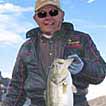 Rick Seaman is a fishing enthusiast with over five decades of fishing experience, a retired tournament fisherman, author of numerous published articles on fishing, and co-author of the book "Bass Fishing - It's not WHAT you throw, It's WHERE you throw it".
Rick Seaman is a fishing enthusiast with over five decades of fishing experience, a retired tournament fisherman, author of numerous published articles on fishing, and co-author of the book "Bass Fishing - It's not WHAT you throw, It's WHERE you throw it".
 Contact Information
Contact Information
City Of Wilson Buckhorn Lake & Shelter
8177 Rock Ridge School Rd
Sims, NC 27880
252 399-7530
Fishing lakes in each state
101125
Buckhorn Reservoir, NC Report
NORTH CAROLINA


Fishing for bass, trout and muskie in east central NC


